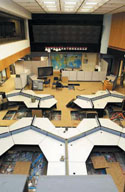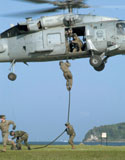Renovations Revitalize Operations
 |
| The first phase of renovation of the U.S. Marine Corps Forces, Pacific (MARFORPAC) Command Operation Center (COC) was to remove all the antiquated equipment. The COC’s upgrade requires removal of all hardware down to the last keyboard before the new equipment can be moved in and installed. Photograph by Cpl. R. Drew Hendricks, USMC |
The largest field command in the U.S. Marine Corps is updating equipment to enhance command and control operations. The upgrades include installing cutting-edge technology that will improve control of troops and communications among the various command levels, as well as integrating better intelligence capabilities and serving as a convergence point during critical missions.
U.S. Marine Forces, Pacific (MARFORPAC) is renovating its new Command Operation Center (COC) at Camp H.M. Smith,
The hardware in the joint operations center was out of date when PACOM vacated the location, and the Marines want to leverage new and emerging technologies to fulfill the MARFORPAC commander’s requirement for strong command and control capabilities over his forces. MARFORPAC personnel tentatively have scheduled the COC to be at full operational capability by November. Renovations began in June with the removal of all the antiquated equipment. MARFORPAC COC operations are being carried out in a temporary location until the renovation is complete.
According to Jose Tablada, director of the MARFORPAC COC, the centerpiece of the newly refurbished facility will be the integration of geospatial technology using a platform supported by various servers and networks, which will be integrated with individual battle cell workstations. Watchstanders will have four networks available at any one time, and the networks will be supported by robust geospatial systems. Tablada explains that the technology MARFORPAC will install combined with its internal command and control processes will support intuitive decision-making by the commander.
Despite the advances and increased capabilities the COC will offer, Tablada doubts most Marines in the Asia-Pacific area will notice a big difference once the center is up and running. Most of them operate at a level several steps below the direct effects of the COC, but leadership’s ability to support their execution and the commander’s ability to command and control will be greatly improved, he says. Tablada believes the changes most Marines in MARFORPAC will experience are quicker response times and increased information sharing among levels of command. The renovated center will enable MARFORPAC staff to respond better to the taskings of the commander of PACOM and to better support operating forces that are being employed in response to any type of contingency or crisis.
Tablada explains that the COC will affect more troops than solely Marines stationed in the Pacific because of the roles MARFORPAC plays. The refitted center will support deployed Marine Corps forces in the Pacific theater, all Marine Corps bases and installations in the Pacific and Marine Corps functions in the Korean peninsula as well as U.S. Defense Department efforts in response to avian influenza. Other military members could benefit from the updated COC as well, depending on mission assignments such as when Marines are assigned to a joint task force. Joint and possibly combined forces could take advantage of the COC technology depending on mission requirements.
In addition to the center’s primary use, it also will serve as a central location during contingency operations or crisis situations. A crisis action team made up of subject matter experts from individual sections across the command will converge on the COC to address a specific problem, issue or emergency at hand.
To ensure that the needs of all the leadership and troops would be met with the refurbishment, MARFORPAC formed an operational planning team comprising members from all staff and special operations sections to determine the requirements for the center. The team developed a statement of objectives instead of a statement of work and released it through the U.S. Marine Corps Systems Command to vendors interested in the project. Tablada says that MARFORPAC told the private sector what the COC needed, and they relied on industry expertise to determine how best to meet those objectives.
General Dynamics Information Technology won the contract for work on the COC. The private industry team will design, install, integrate and test a turnkey audio/video and computer system to replace the current equipment located at the center. The work includes the network design and installation of more than 130 computer workstations integrated into four separate networks with state-of-the-art data projection and switching capabilities for crisis briefing, planning and analysis.
Tablada believes that the hardware being installed equals or surpasses the capabilities he saw during his travel to and research of other COCs, including those at joint commands and the Pentagon. The networks in the renovated COC will make satellite imagery and other geospatial imagery available to Marines, who will have the capability to upload and share the information with other users. In addition, all the sections in MARFORPAC, including G-2 and G-6, as well as the commander’s office and personnel from other commands will be connected and able to collaborate. One major piece of new equipment going into the COC is called the “knowledge wall,” a giant display that measures approximately 27 feet wide x 12 feet high.
 |
| U.S. Marines from the fleet antiterrorism security team fast rope during a training exercise with U.S. Navy explosive ordnance disposal (EOD) technicians from EOD Mobile Unit 5 Detachment Yokosuka at the helicopter pad of Commander Fleet Activities, Yokosuka, Japan. MARFORPAC will improve command and control capabilities over all Marines in its area of responsibility when the refurbished COC opens. |
After the members of the initial operations planning team finished defining their requirements, individuals from the team were selected to form the actual renovation team made up mostly of personnel from operations, communications and intelligence.
In addition to new technologies, new personnel also are required by the COC. The networks that will operate in the center include SIPRNET and NIPRNET along with various coalition networks. These networks will be run by Marines from the G-6, which also will be required to supply personnel to run the backside of the network operations center of the COC.
When work on the COC is finished, the center could serve as a high-level model for other COCs across the Marine Corps. However, Tablada points out that because of the differing mission requirements of the various commands at the component level and below, no cookie cutter template can apply across the board.
To illustrate the point, Tablada contrasts MARFORPAC with the U.S. Marine Corps Central Command (MARCENT). MARFORPAC serves more as a force provider, whereas MARCENT is a supported command. Because of the differing roles and responsibilities, the two organizations have different requirements. But Tablada says MARCENT could implement what is applicable to its mission needs from the MARFORPAC COC renovation. He also believes that many of the technologies and concepts as well as the command and control methodology MARFORPAC is applying will be shared at lower levels.
Web Resources
U.S. Marine Forces, Pacific: www.mfp.usmc.mil
General Dynamics Information Technology: www.gdit.com




Comments